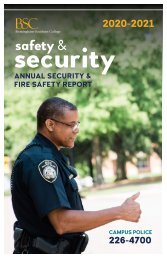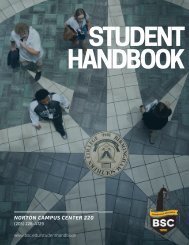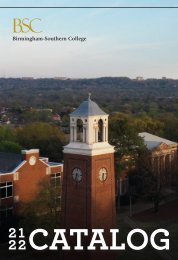Emergency Response Manual - 2023
Create successful ePaper yourself
Turn your PDF publications into a flip-book with our unique Google optimized e-Paper software.
CAMPUS POLICE<br />
BSC<br />
Birmingham-Southern College<br />
<strong>Emergency</strong><br />
<strong>Response</strong> <strong>Manual</strong>
PREFACE<br />
This emergency procedure manual has been designed to provide a contingency plan for<br />
the Birmingham-Southern College community in the event of a campus emergency. While<br />
the guide does not address every conceivable situation, it does supply the basic guidelines<br />
necessary to cope with most campus emergencies.<br />
This manual is the product of research with numerous emergency agencies, as well as<br />
colleges and universities throughout the state. Any procedural change(s) or suggestion(s)<br />
should be submitted for review to the <strong>Emergency</strong> Director.<br />
Where and when applicable, the “Birmingham-Southern College <strong>Emergency</strong> <strong>Response</strong><br />
<strong>Manual</strong>” should be adhered to by the entire College community.<br />
NOTE:<br />
Unless otherwise noted, the Area Code for all phone numbers in this<br />
manual is 205.<br />
PURPOSE<br />
The basic emergency procedures outlined in this manual are designed to enhance the<br />
protection of lives and property through effective use of College and campus community<br />
resources. Whenever an emergency affecting the campus reaches proportions that<br />
cannot be handled by routine measure, the President, his designee, or VP for<br />
Administration and Chief Operating Officer may declareastateofemergency.<br />
MEDIA RELATIONS<br />
Only authorized persons will speak to the media concerning BSC incidents.<br />
Generally, authorization will be coordinated through the Office of<br />
Communications. Under no circumstances should an employee of BSC speak to the<br />
media unless directed to do so.<br />
EMERGENCY TEXT MESSAGING SYSTEM<br />
BSC ALERT!<br />
In the event of extreme incidents when the potential for loss of life exists, or during<br />
times when all other sources of communications within the campus community are<br />
not available, the BSC emergency alert system will be utilized.<br />
This system, provided via text messaging, and e-mail where applicable,<br />
is available to all current students, faculty, and staff at BSC that have opted into the<br />
program.
QUICK REFERENCE<br />
TYPES OF EMERGENCIES<br />
PAGE<br />
A. FIRE ---------------------------------------------------------------------------------- 16<br />
B. EARTHQUAKE -------------------------------------------------------------------- 17<br />
C. CHEMICAL SPILL EXPLOSION --------------------------------------------- 18<br />
D. EXPLOSION, DOWNED AIRCRAFT (CRASH) ------------------------- 19<br />
E. CIVIL DISTURBANCE OR DEMONSTRATION -------------------- 20-22<br />
F. UTILITY FAILURE ---------------------------------------------------------------- 23<br />
G. VIOLENT OR CRIMINAL BEHAVIOR ------------------------------------- 24<br />
H. MEDICAL/FIRST AID (EPIDEMIC/POISONING) -------------------- 25<br />
I. PSYCHOLOGICAL CRISIS ---------------------------------------------------- 26<br />
J. TORNADO --------------------------------------------------------------------- 27-28<br />
K. BOMB THREAT --------------------------------------------------------------- 29-30<br />
L. INCLEMENT WEATHER/SCHOOL CLOSING ---------------------- 31-34<br />
TO REPORT EMERGENCIES CALL THE<br />
CAMPUS POLICE AT:<br />
205-226-4700
TABLE OF CONTENTS<br />
Definitions of an <strong>Emergency</strong>.....................................................................................................4<br />
Assumptions...............................................................................................................................4<br />
Declaration of State of <strong>Emergency</strong>............................................................................................5<br />
DIRECTION AND COORDINATION:<br />
<strong>Emergency</strong> Director....................................................................................................................5<br />
CAMPUS EMERGENCY RESPONSE TEAM:<br />
Team Members’ Responsibilities………...……………………………………....................... 6-9<br />
Current Team Members………...……………………………………....................................... 10<br />
Additional Key Personnel………...…………………………………….................................... 10<br />
RESPONSIBILITIES:<br />
<strong>Emergency</strong> Preparedness....................................…………………………………….….…….11<br />
<strong>Emergency</strong> Situations....................................…….....……………………………….….…….11<br />
EVACUATION LOCATIONS BUILDING COORDINATORS..............................................................12<br />
ON/OFF- CAMPUS SOURCES OF ASSISTANCE:<br />
On-Campus Assistance............................................................................................................13<br />
Off-Campus Assistance............................................................................................................13<br />
Disaster Resources....................................................................................................................14<br />
2
CAMPUS EMERGENCY PROCEDURES AND GUIDELINES:<br />
Reporting Emergencies............................................................................................................14<br />
Evacuation Procedures.............................................................................................................15<br />
Fire............................................................................................................................................16<br />
Earthquake................................................................................................................................17<br />
Chemical or Radiation Spill / Explosion..…………………………………………………....18<br />
Explosion and or Downed Aircraft (Crash)…………………………………………...……...19<br />
Civil Disturbance or Demonstrations................................................................................20-21<br />
Directives Associated with Demonstrations...........................................................................22<br />
Utility Failure…………………………………………………………………………………...23<br />
Violent or Criminal Behavior..................................................................................................24<br />
Medical/First Aid (Epidemic/Poisoning)................................................................................25<br />
Psychological Crisis..................................................................................................................26<br />
Tornado/Severe Weather.................................................................................................... 27-28<br />
Bomb Threat…………………………………………………………………………….………29<br />
Bomb Threat Report Form…………………………………………………………………..…30<br />
Inclement Weather/Declaration of School Closing..........................................................31-34<br />
3
DEFINITIONS OF AN EMERGENCY<br />
A. MINOR EMERGENCY: Any incident, potential or actual, which will not<br />
seriously affect the overall functional capacity of the College. Report<br />
immediately to the Campus Police at Ext. 4700, 4701, 4702, 4705.<br />
B. MAJOR EMERGENCY: Any incident, potential or actual, which affects an<br />
entire building or buildings, and which will disrupt the overall operation of<br />
the College. Outside emergency services may be required, as well as major<br />
efforts from campus support services. Major policy considerations and<br />
decisions will usually be required from the College Administration during<br />
times of crisis. Report immediately to the Campus Police at 4700, 4701,<br />
4702, 4705.<br />
C. DISASTER: Any event or occurrence which has taken place and has<br />
seriously impaired or halted the operations of the College. In some cases,<br />
mass personnel casualties and severe property damage may be sustained. A<br />
coordinated effort of all campus-wide resources is required to effectively<br />
control the situation. Outside emergency services will be essential.<br />
In addition, the <strong>Emergency</strong> Director or others should promptly report any incident<br />
that has the potential for adverse publicity concerning the College to the Office of<br />
Communications.<br />
ASSUMPTIONS<br />
A. An emergency or disaster may occur any time of day or night, weekend or<br />
holiday, with little or no warning.<br />
B. The succession of events in an emergency are not predictable, hence,<br />
published support and operational plans will serve only as a guide<br />
and, checklist, and may require field modification in order to meet the<br />
requirements of the emergency.<br />
C. Disasters may affect residents in the geographical location of the College;<br />
therefore, city, county and federal emergency services may not be available.<br />
A delay in off-campus emergency services may be extended for unknown<br />
lengths of time.<br />
D. A major emergency may be declared if information indicates that such a<br />
condition is developing or is probable.<br />
4
DECLARATION OF STATE OF EMERGENCY<br />
During a time of campus emergency, the Campus Police shall place into effect<br />
immediately the appropriate procedures necessary to meet the emergency, safeguard<br />
persons and property, and maintain educational facilities. The Campus Police shall<br />
immediately consult with the <strong>Emergency</strong> Director and/or the Campus Police Chief.<br />
If unable to contact the above persons, the President should be contacted directly<br />
regarding the emergency and possible need for a declaration of a state of emergency.<br />
When this declaration is made, only registered students, faculty, staff and persons required<br />
by employment are authorized to be present on campus. Those who cannot present<br />
proper ID (registration or employee ID card, or other ID) showing their legitimate<br />
business on campus will be asked to leave the campus. Unauthorized persons remaining<br />
on campus may be subject to arrest.<br />
In addition, only those faculty and staff members who have been assigned <strong>Emergency</strong><br />
<strong>Response</strong> Team duties or issued an emergency pass by the Campus Police Department<br />
will be allowed to enter the disaster area.<br />
In the event of earthquakes, aftershocks, fires, storms, or major disasters occurring in or<br />
about the campus which involve College property the Campus Police officers will be<br />
dispatched to determine the extent of any damage to College property.<br />
DIRECTION AND COORDINATION<br />
EMERGENCY DIRECTOR<br />
The VP for Administration and Chief Operating Officer or his designee, serves as the<br />
overall <strong>Emergency</strong> Director during any major emergency or disaster. The <strong>Emergency</strong><br />
Director will be responsible for all operational control and direction during a declared<br />
state of emergency.<br />
When an emergency occurs, the on-duty Campus Police supervisor will be in charge until<br />
relieved by the <strong>Emergency</strong> <strong>Response</strong> Team.<br />
5
CAMPUS EMERGENCY RESPONSE TEAM<br />
The <strong>Emergency</strong> <strong>Response</strong> Team is comprised of key campus personnel with<br />
responsibilities as defined below. It shall be the decision of the <strong>Emergency</strong> Director as<br />
to when the Team is activated, and to where they should meet for instruction. Team<br />
members will be responsible for acquiring assistance from additional staff personnel in<br />
their respective areas as needed. Team members, responsibilities and contact numbers are<br />
as follows:<br />
EMERGENCY DIRECTOR: VP for Administration and Chief Operating Officer or designee.<br />
ASSISTANT EMERGENCY DIRECTOR: Campus Police Chief.<br />
CAMPUS POLICE: All officers and safety resources as directed.<br />
COMMUNICATIONS: Director of Communications.<br />
DAMAGE CONTROL: Director of Operations.<br />
HAZARDOUS MATERIALS: Designated by BSC Chemistry Department.<br />
HUMAN RESOURCES: Director of Human Resources.<br />
INFORMATION TECHNOLOGY: Vice President for Information Technology.<br />
COUNSELING SERVICES: Director of Personal Counseling.<br />
STUDENT DEVELOPMENT: Vice President for Student Development.<br />
Additionally, team members may request assistance from others in their respective areas<br />
as they feel appropriate to deal with emergencies.<br />
6
TEAM MEMBER RESPONSIBILITIES<br />
1. EMERGENCY DIRECTOR:<br />
A. Is responsible for the overall direction of the College emergency response.<br />
B. Works with Assistant <strong>Emergency</strong> Director and others in assessing the<br />
emergency and preparing the College’s specific response.<br />
C. Declares and ends, when appropriate, the campus state of emergency as<br />
provided for in this guide.<br />
D. Notifies and conducts liaison activities with the College administration,<br />
governmental agencies, <strong>Emergency</strong> <strong>Response</strong> Team, and others as necessary.<br />
E. Notifies and conducts liaison activities with appropriate outside<br />
organizations such as fire, police, etc.<br />
F. Ensures that appropriate notification is made to off-campus staff when<br />
necessary.<br />
G. Performs other related duties as may be directed by virtue of the campus<br />
emergency.<br />
H. Prepares and submits a report to the President describing the final outcome<br />
of the emergency.<br />
I. Informs everyone in possession of <strong>Emergency</strong> <strong>Manual</strong>s of procedural or<br />
personnel changes.<br />
2. ASSISTANT EMERGENCY DIRECTOR: (or CP supervisor on duty until relieved)<br />
A. Responsible for the overall coordination of the College emergency response.<br />
B. Determines the type and magnitude of the emergency and establishes the<br />
appropriate emergency command post.<br />
C. Initiates immediate contact with the <strong>Emergency</strong> Director and begins<br />
assessment of the College’s condition.<br />
D. Notifies and utilizes police, Campus Police, and other emergency resources.<br />
E. Notifies members of the <strong>Emergency</strong> <strong>Response</strong> Team and advises them of the<br />
nature of the emergency.<br />
3. CAMPUS POLICE:<br />
A. Maintains the Campus Police Office in a constant state of readiness.<br />
B. Notifies College administrators of major emergencies.<br />
C. Monitors campus emergency warning and evaluation system.<br />
D. Establishes an <strong>Emergency</strong> Command Post as follows.<br />
• FIELD EMERGENCY COMMAND POST<br />
During small-scale incidents, a patrol vehicle or small office is to be used<br />
until the emergency ends. The “Field <strong>Emergency</strong> Command Post should<br />
7
have the following equipment:<br />
a. Barricades, barrier tape<br />
b. Portable hand-held radios<br />
c. Portable public address system<br />
d. First-aid kit<br />
e. Campus/local/Yellow Pages telephone directories<br />
• GENERAL EMERGENCY COMMAND POST<br />
During large-scale incidents a command post will be established at the<br />
Campus Police Office if it is available. If unavailable, the <strong>Emergency</strong><br />
Director will select an appropriate alternate location.<br />
4. HUMAN RESOURCES:<br />
A. Provides and maintains human resources needed for the duration of the<br />
incident.<br />
B. Assesses the needs and provides human resources dealing with the<br />
aftermath of incident.<br />
5. COUNSELING SERVICES:<br />
Provides counseling as needed.<br />
6. DAMAGE CONTROL:<br />
A. Provides equipment and personnel to perform shutdown procedures,<br />
hazardous area control, barricades, damage assessment, debris clearance,<br />
emergency repairs and equipment protection.<br />
B. Provides vehicles, equipment operators for movement of personnel and<br />
supplies, assigns vehicles as required to <strong>Emergency</strong> <strong>Response</strong> Team for<br />
emergency use.<br />
C. Obtains the assistance of utility companies as required for emergency<br />
operations.<br />
D. Furnishes emergency power and lighting system as required.<br />
7. STUDENT DEVELOPMENT:<br />
A. Is present at emergency to provide students and parents with information<br />
concerning emergency.<br />
B. Assists student population in responding appropriately to the emergency.<br />
8
8. COMMUNICATIONS:<br />
A. Coordinates, with approval of the president or his designee, the college’s<br />
response to the media, including those members of the campus community<br />
who will be designated to talk directly with the media.<br />
B. Establishes contact with public media as directed by the President.<br />
C. Establishes contact with local TV and radio stations for public announcements.<br />
D. Arranges for photographic and audio-visual services.<br />
E. Advises President or designee of all news covering the situation or<br />
emergency affecting campus.<br />
F. Prepares news releases for approval and releases to media concerning<br />
emergency.<br />
9. HAZARDOUS MATERIALS:<br />
Will be available to provide resource assistance on the scene when an<br />
emergency occurs involving the handling and/or disposal of possible<br />
hazardous waste and/or radioactive material. This type emergency might be<br />
a fire, tornado, or damage to the Elton B. Stephens Science Center.<br />
10. INFORMATION TECHNOLOGY:<br />
A. Maintains phone systems and arranges for outside assistance as required.<br />
B. Arranges for telecommunications at command posts.<br />
9
CURRENT TEAM MEMBERS<br />
EMERGENCY DIRECTOR Lane Estes<br />
W 226-4641 C 218-5798<br />
ASST. EMER. DIRECTOR Chief Jeff Harris<br />
W 226-4701<br />
CAMPUS POLICE Lt. Wes Newman<br />
W 226-4702<br />
COMMUNICATIONS Richard Nieves<br />
W 226-4919<br />
DAMAGE CONTROL Randal Johnson<br />
W 226-4772<br />
HAZARDOUS MATERIALS Isa Delgado<br />
W 226-4856<br />
HUMAN RESOURCES Vanessa Crawford Jones<br />
W 226-4644<br />
INFORMATION TECHNOLOGY Anthony Hambey<br />
W 226-4850<br />
C 937-0220<br />
C 335-9052<br />
C 603-7180<br />
C 217-577-3522<br />
C 639-3859<br />
C 407-808-8992<br />
C 218-1459<br />
COUNSELING SERVICES Head of Counseling<br />
W 226-4727<br />
STUDENT DEVELOPMENT<br />
Dr. David Eberhardt H 335-9655 W 226-4731<br />
C 218-4377<br />
Area codes are 205 unless otherwise noted.<br />
ADDITIONAL KEY PERSONNEL<br />
PRESIDENT<br />
Daniel Coleman<br />
W 226-4621<br />
C 312-806-3165<br />
INT. PROVOST<br />
Dr. Laura Sultz<br />
W 226-4650<br />
C 837-5889<br />
FOOD SERVICE<br />
Jason Hall<br />
W 226-4713<br />
C 678-923-0112<br />
BSC NURSE<br />
Yvette Spencer<br />
H 995-0594 W 226-7720<br />
C 936-9175<br />
INSTITUTIONAL ADVANCEMENT Virginia Gilbert Loftin W 226-4938<br />
C 223-7141<br />
10
RESPONSIBILITIES<br />
Building Coordinators, House Directors, House Managers, Resident Advisors<br />
In every occupied building on campus a specific contact person will be designated to act<br />
as emergency coordinator. In the academic buildings that person will be the Building<br />
Coordinator. In the residence halls that person will be the House Director and the<br />
House Manager will serve in that role for the sorority/fraternity houses. The emergency<br />
coordinator will be responsible for the following:<br />
A. <strong>Emergency</strong> Preparedness<br />
1. Ensure that evacuation information is posted on each floor of the building.<br />
2. Ensure that the location of the area in the building designated for use<br />
during tornado warnings is posted on each floor.<br />
3. Establish a site away from the building for gathering and head counts<br />
during evacuations. The site location should be posted in the building with<br />
other emergency information. As a general rule the site should be at least<br />
100 feet from the building. See page 14 for current locations.<br />
4. Ensure that persons in the building are familiar with fire safety measures.<br />
(Fire alarms and pull stations, fire extinguishers, etc.)<br />
B. <strong>Emergency</strong> Situations<br />
1. CALL CAMPUS POLICE AT EXTENSION 47OO.<br />
2. Coordinate informing all individuals in the building of an emergency.<br />
3. Evaluate the impact the emergency has on the building’s activity and take<br />
appropriate action. This may include ceasing operations and initiating<br />
building evacuation.<br />
4. Maintain contact with emergency operations.<br />
IMPORTANT: Inform anyone in the area you supervise to conform to building<br />
evacuation guidelines during an emergency and to report to a pre-designated<br />
campus assembly area outside the building or emergency site where a head count<br />
can be taken.<br />
11
EVACUATION LOCATONS<br />
ADMISSIONS ................................................................................................... BRUNO DRIVE<br />
ART BUILDING...........................................................................................ACADEMIC QUAD<br />
BASEBALL COMPLEX......................................................................... TENNIS COURT LOT H<br />
BERTE HUMANITIES..................................................................................ACADEMIC QUAD<br />
CAMPUS POLICE GATE................................................................................... BRUNO DRIVE<br />
CHAPEL...........................................................................................................SIMPSON LOT E<br />
COLISEUM........................................................................................................ NORTH LOT G<br />
HARBERT.....................................................................................................ACADEMIC QUAD<br />
LIBRARY.......................................................................................................ACADEMIC QUAD<br />
METH. HDQ......................................................................................... SOCCER FIELD TRACK<br />
HILL.............................................................................................................ACADEMIC QUAD<br />
MUNGER.....................................................................................................ACADEMIC QUAD<br />
NORTON.....................................................................................................ACADEMIC QUAD<br />
OLIN................................................................................................................SIMPSON LOT E<br />
OPERATIONS.......................................................................................... INTRAMURAL FIELD<br />
PHILL. BAND. ..........................................................................................ACADEMIC QUAD<br />
GEODOME ..............................................................................................SIMPSON LOT E<br />
SPORTS CENTER........................................................................................ACADEMIC QUAD<br />
STEPHENS SCIENCE..................................................................................ACADEMIC QUAD<br />
STOCKHAM................................................................................................ACADEMIC QUAD<br />
STUDENT SERVICES......................................................................................... NORTH LOT G<br />
STRIPLIN FITNESS............................................................................................ BRUNO DRIVE<br />
THEATRE.....................................................................................................ACADEMIC QUAD<br />
RESIDENCE HALLS<br />
BRUNO.............................................................................................RESIDENCE HALL QUAD<br />
CULLEN DANIEL.............................................................................RESIDENCE HALL QUAD<br />
DANIEL............................................................................................... OLD TENNIS COURT H<br />
FRATERNITY HOUSES...................................................................................... BRUNO DRIVE<br />
PIERCE..............................................................................................RESIDENCE HALL QUAD<br />
LAKEVIEW........................................................................................RESIDENCE HALL QUAD<br />
HANSON........................................................................................................... NORTH LOT G<br />
MARGARET DANIEL........................................................................RESIDENCE HALL QUAD<br />
NEW MEN’S......................................................................................................SOCCER FIELD<br />
SORORITY HOUSES.......................................................................................SIMPSON LOT E<br />
APARTMENTS ........................................................................................................ POOL AREA<br />
NOTICE: In the event that the above pre-designated assembly points are not available as<br />
a result of the emergency, go to a safe area.<br />
12
CAMPUS SOURCES<br />
OF EMERGENCY ASSISTANCE<br />
Campus Police……………........…………226-4700, 4701, 4702, 4705, 205-251-7400, 205-365-4067<br />
Administration…..………………………………………………………………....…..226-4640<br />
Chemistry Department…………………………………………………………….......226-4870<br />
Communications…………………………………………………………………….....226-4922<br />
Counseling Services......…………………………………………………………….......226-4717<br />
Associate Dean of Students…......................................................………………………........….226-4728<br />
VP of Student Development ………………………………………………………......226-4731<br />
Health Services………………………………………………………...……….....……226-7720<br />
Operations………………………………………………....……..226-4773, 4772<br />
Purchasing………………………………………………………………......…..226-4643<br />
Residence Life…………………………………………………………………….....….226-4723<br />
Student Development………………………………………………………......226-4722, 4729<br />
Department of Information Technology……………………………….....………….226-3033<br />
OFF- CAMPUS SOURCES OF EMERGENCY ASSISTANCE<br />
Federal Bureau of Investigation…………………………………………….....……….326-6166<br />
Birmingham Police Department………………………………………....…….....328-9311, 911<br />
Birmingham Fire Department………………………….………………………. 250-7575 , 911<br />
Alabama State Troopers Office……………………………………………….....……..322-4691<br />
Alabama State Highway Department………………………………………....………328-5820<br />
Jefferson County Highway Department………………………………………....……325-5142<br />
Jefferson County Sheriff’s Office…………………………………………….....……...325-1450<br />
13
Local Hospitals<br />
UAB Highland (Formerly Health South) Hospital................................................... 930-7050<br />
Princeton Hospital......................................................................................................783-3000<br />
St. Vincent’s Hospital...................................................................................................939-7100<br />
University Hospital......................................................................................................934-5105<br />
Local Agencies<br />
Salvation Army.............................................................................................................252-8151<br />
Jefferson County <strong>Emergency</strong> Management Agency................................................... 254-2039<br />
State <strong>Emergency</strong> Management Agency............................................................ 1-205-280-2200<br />
Federal <strong>Emergency</strong> Management Agency-National.......202-646-3900-Local 770-220-5200<br />
County Commission...................................................................................................325-5555<br />
Crisis Center........................................................................205-323-7777 or 1-800-273-TALK<br />
Local Television Stations:<br />
FOX Channel 6………………………………………..……………..…….322-6666<br />
CBS Channel 42……………………………………………………....……322-4665<br />
NBC Channel 13……………………………………………………..….….933-1313<br />
ABC Channel 33/40………………………………………………..……...982-3970<br />
REPORTING EMERGENCIES<br />
1. Report all emergencies to Campus Police at 226-4700!<br />
2. IN AN EMERGENCY WHEN THE CAMPUS POLICE CANNOT BE REACHED<br />
DIAL: 226-4600, 226-4640, or 226-4773.<br />
3. When calling, stay calm and carefully explain the problem and location to the<br />
Campus Police Dispatcher. DO NOT HANG UP UNTIL TOLD TO DO SO.<br />
14
EMERGENCY EVACUATION PROCEDURES<br />
1. Building Evacuation<br />
A. All building evacuations will occur on notification by Campus Police or by<br />
individual choice when the emergency dictates.<br />
B. When notification occurs, leave by the nearest marked exit and alert others<br />
to do the same.<br />
C. Assist disabled persons leaving the building! Do not use elevators in the<br />
event of fire, earthquakes, or other emergencies where you could become<br />
trapped in the elevator.<br />
D. Once outside, proceed to a clear area that is at least 100 feet away from the<br />
affected building. Keep streets, fire lanes, hydrant areas and walkways clear<br />
for emergency vehicles and personnel.<br />
2. Campus Evacuation<br />
A. The evacuation of all or part of the campus grounds will be announced by<br />
Campus Police or the <strong>Emergency</strong> Director.<br />
B. All persons are to vacate immediately the area in question and relocate to<br />
another part of the campus or location as directed.<br />
BE SURE TO SIGN UP FOR THE<br />
BSC ALERT<br />
TEXT MESSAGING SYSTEM<br />
15
FIRE<br />
REPORT ALL FIRES TO THE CAMPUS POLICE!<br />
1. Know the location of fire extinguishers, fire exits, and alarm systems in your area<br />
and know how to use them. Training and information is available from the<br />
Campus Police. CAUTION!! NEVER USE A WATER FIRE EXTINGUISHER ON AN<br />
ELECTRICAL FIRE.<br />
2. If a minor fire appears controllable, IMMEDIATELY activate the building fire alarm<br />
and call the Campus Police. Then promptly direct the charge of fire extinguisher<br />
toward the base of the fire.<br />
3. If an emergency exists, activate the building fire alarm.<br />
4. On fires that do not appear controllable, IMMEDIATELY activate the building<br />
alarm and call the Campus Police. Evacuate all rooms, closing all doors to confine<br />
the fire and reduce oxygen -- DO NOT LOCK DOORS.<br />
5. When the building fire alarm is sounded, an emergency exists. Walk quickly to the<br />
nearest marked exit and alert others to do the same.<br />
6. Assist disabled persons in exiting the building! DO NOT USE THE ELEVATORS<br />
DURING A FIRE! Smoke is the greatest danger in a fire, so stay near the floor<br />
where the air will be less toxic.<br />
7. Once outside, move to a clear area at least 500 feet away from the affected building.<br />
Keep streets, fire lanes, hydrants, and walkways clear for emergency vehicles and<br />
crews.<br />
8. If requested, assist emergency crews as necessary.<br />
9. A Campus <strong>Emergency</strong> Post may be set up near the emergency site. Keep clear of<br />
the command post unless you have official business.<br />
10. DO NOT RETURN TO AN EVACUATED BUILDING unless told to do so by a<br />
College official.<br />
NOTE:<br />
NOTE:<br />
If you become trapped in a building during a fire and a window is<br />
available, place an article of clothing outside the window as a marker for<br />
rescue crews. If there is no window, stay near the floor where the air will<br />
be less toxic. Shout at regular intervals to alert emergency crews of your<br />
location.<br />
Campus Fire Systems are monitored by a UL-approved monitoring<br />
company. When a system goes into alarm, the monitoring company first<br />
contacts the Birmingham Fire Dept., and then contacts the BSC CPD.<br />
BSC CPD repsonds immediately to the building in alarm in order to 1)<br />
assist the building’s occupants, 2) determine if an actual fire exists, 3)<br />
determine how building fire (sprinkler) pumps can be started, and<br />
4) ascertain their locations within the building/structure.<br />
The Fire Pump Operator:<br />
When the fire alarm sounds, the fire pump operator checks the automatic<br />
16
NOTE:<br />
starting pump, starts it if it hasn’t already automatically, and keeps it<br />
operating until instructed to shut it down. Preferably, the person most<br />
familiar with the operation and care of the pumps should be assigned<br />
the job of fire pump operator in case it fails to start of is not running<br />
properly. If that person is unavailable, the person assigned to the job<br />
should be thoroughly trained in starting the pumps manually and<br />
should understand the pumps’ importance to fire protection.<br />
This recommendation assumes the fire pump is in a location safe for the<br />
fire pump operator in the event of a fire.<br />
EARTHQUAKE<br />
During an earthquake, remain calm and quickly follow the steps outlined below:<br />
1. If indoors, seek refuge in a doorway or under a desk or table. Stay away from glass<br />
windows, shelves, and heavy equipment.<br />
2. If outdoors, move quickly away from buildings, utility poles and other structures.<br />
CAUTION! Always avoid power or utility lines as they may be energized. Know<br />
your assembly point.<br />
3. If in an automobile, stop in the safest place available, preferably away from power<br />
lines and trees. Stop as quickly as safety permits, but stay in the vehicle for the<br />
shelter it offers.<br />
4. After the initial shock, evaluate the situation and if emergency help is necessary,<br />
call the Campus Police. Protect yourself at all times and be prepared for<br />
aftershocks.<br />
5. Damaged facilities should be reported to Campus Police and Operations. NOTE:<br />
Gas leaks and power failures create special hazards. Please refer to the section on utility<br />
failures.<br />
6. If an emergency exists, activate the building’s fire alarm.<br />
7. If the building fire alarm is sounded, walk to the nearest marked exit and ask<br />
others to do the same.<br />
8. Assist the disabled in exiting the building! Remember elevators are reserved for<br />
disabled persons’ use. DO NOT USE ELEVATORS IN CASE OF FIRE. DO NOT<br />
PANIC.<br />
9. Once outside, move to a clear area at least 500 feet away from the affected<br />
buildings. Keep streets, fire lanes, hydrants and walkways clear for emergency<br />
vehicles and crews.<br />
10. If requested, assist emergency crews as necessary.<br />
11. A Campus <strong>Emergency</strong> Command Post may be set up near the emergency site. Keep<br />
clear of the Command Post unless you have official business.<br />
12. DO NOT RETURN TO AN EVACUATED BUILDING unless told to do so by a<br />
College official.<br />
17
CHEMICAL OR RADIATION SPILL/EXPLOSION<br />
1. Any spillage of a hazardous chemical or radioactive material is to be reported<br />
immediately to Campus Police who shall in turn contact the hazardous material<br />
member of the <strong>Emergency</strong> <strong>Response</strong> Team.<br />
2. When reporting, be specific about the nature of the involved material and exact<br />
location.<br />
3. The key person on the site should vacate the affected area at once and seal it off<br />
to prevent further contamination of other areas until arrival of Campus Police<br />
personnel.<br />
4. Anyone who may be contaminated by the spill is to avoid contact with others as<br />
much as possible, remain in the vicinity, and give their name(s) to the Campus<br />
Police.<br />
5. If an emergency exists in your building, activate the building fire alarm.<br />
6. When the building fire alarm is sounded, an emergency exists. Walk quickly to the<br />
nearest marked exit, and alert others to do the same.<br />
7. Assist disabled persons in exiting the building! Remember that elevators are<br />
reserved for disabled persons’ use. DO NOT USE ELEVATORS IN CASE OF FIRE.<br />
DO NOT PANIC.<br />
8. Once outside, move to a clear area at least 500 feet away from the affected<br />
buildings. Keep streets, fire lanes, hydrants and walkways clear for emergency<br />
vehicles and crews.<br />
9. If requested, assist emergency crews as necessary.<br />
10. A Campus <strong>Emergency</strong> Command Post may be set up near the emergency site. Keep<br />
clear of the site unless you have official business.<br />
11. DO NOT RETURN TO AN EVACUATED BUILDING unless told to do so by a<br />
College official.<br />
IMPORTANT:<br />
After any evacuation, report to your designated area assembly<br />
point. Stay there until an accurate head count is taken. The<br />
Building Coordinator will assist with the accounting of all<br />
building occupants.<br />
18
EXPLOSION AND/OR AIRCRAFT DOWN (CRASH) ON CAMPUS<br />
In the event a mishap occurs, such as an explosion or a downed aircraft (crash) on campus,<br />
take the following action:<br />
1. Immediately take cover under tables, desks and other objects, which will give<br />
protection against falling glass or debris.<br />
2. After the effects of the explosion and/or fire have subsided, notify the Campus<br />
Police Department. Give your name and location and the nature of the emergency.<br />
3. If necessary, or when directed to do so, activate the building fire alarm.<br />
4. If the building fire alarm is sounded, or when told to leave by College officials,<br />
walk quickly to the nearest marked exit and ask others to do the same.<br />
5. Assist the disabled persons in exiting the building. Remember elevators are<br />
reserved for disabled persons. DO NOT USE ELEVATORS IN CASE OF FIRE. DO<br />
NOT PANIC.<br />
6. Once outside, move to a clear area that is at least 500 feet from the affected<br />
building. Keep streets and walkways clear for emergency vehicles and crews.<br />
KNOW YOUR AREA ASSEMBLY POINT.<br />
7. If requested, assist emergency crews as necessary.<br />
8. A Campus <strong>Emergency</strong> Post may be set up near the disaster site. Keep clear of the<br />
command post unless you have official business.<br />
9. DO NOT RETURN TO AN EVACUATED BUILDING unless told to do so by a<br />
College official.<br />
IMPORTANT:<br />
After any evacuation, report to your designated assembly<br />
point. Stay there until an accurate head count is taken.<br />
The Building Coordinator will assist in the accounting for all<br />
building occupants.<br />
19
CIVIL DISTURBANCE OR DEMONSTRATIONS<br />
Most campus demonstrations such as marches, meetings, picketing, and rallies will be<br />
peaceful and non-obstructive. A student demonstration should not be disrupted unless<br />
one or more of the following conditions exist as a result of the demonstration:<br />
A. Interference with normal operations of the College.<br />
B. Prevention of access to offices, buildings or other College facilities.<br />
If either of these conditions exist, Campus Police should be notified and will be<br />
responsible for contacting and informing the <strong>Emergency</strong> Director and/or the President of<br />
the College. Depending on the nature of the demonstration, the appropriate procedures<br />
listed below should be followed.<br />
PEACEFUL, NON-OBSTRUCTIVE DEMONSTRATIONS<br />
A. Generally, demonstrations of this kind should not be interrupted.<br />
Demonstrators should not be obstructed or provoked and efforts should be<br />
made to conduct business as normally as possible.<br />
B. If demonstrators are asked to leave, but refuse to leave by regular facility<br />
closing time:<br />
* Arrangements will be made by the Campus Police Chief to monitor<br />
the situation during non-business hours or,<br />
* Determination will be made to treat the violation of regular closing<br />
hours as a disruptive demonstration. (See next section)<br />
NON-VIOLENT, DISRUPTIVE DEMONSTRATIONS<br />
A. In the event that a demonstration blocks access to College facilities or<br />
interferes with operation of the College:<br />
* Demonstrators will be asked to terminate the disruptive activity by<br />
the <strong>Emergency</strong> Director or designee.<br />
* The <strong>Emergency</strong> Director will consider having a photographer<br />
available. Key College personnel may be requested to go to the<br />
demonstration site in order to reason with the demonstrators. This<br />
may also include student leaders.<br />
* If the demonstrators persist in disruptive activity, they will be<br />
apprised that failure to discontinue the specified action within a<br />
determined length of time may result in disciplinary action including<br />
suspension or expulsion or possible intervention by the civil<br />
authorities. (See Directive A, p.24.)<br />
* Efforts shall be made to photograph or to secure positive<br />
identification to be used to facilitate later testimony.<br />
* After consultation with the President of the College or <strong>Emergency</strong><br />
Director, it will be determined if further measures are required by the<br />
Campus Police or by civil authorities.<br />
* If the determination is made to seek intervention by civil authorities,<br />
the demonstrators should be so informed. Upon arrival of the<br />
Birmingham Police Department, the remaining demonstrators will<br />
be notified of the intent to arrest. (See Directive B, p.24.)<br />
20
VIOLENT, DISRUPTIVE, DEMONSTRATIONS<br />
In the event that a violent demonstration in which injury to persons or property occurs or<br />
appears eminent, the President, the VP for Administration and Chief Operating Officer and<br />
the VP for Student Development shall be notified.<br />
A. During Business Hours<br />
* In coordination with <strong>Emergency</strong> Director, the Birmingham Police<br />
Department shall be notified by the Campus Police to photograph<br />
the events.<br />
* The <strong>Emergency</strong> Director or designee will determine the need for a<br />
photographer to report to an advantageous position to photograph<br />
the events.<br />
* The President, <strong>Emergency</strong> Director and other College officials who<br />
are deemed necessary shall consult to determine the need for an<br />
injunction.<br />
* The BSC Campus Police will provide the BPD with a portable radio<br />
to serve as communication between the two agencies.<br />
B. After Business Hours<br />
* The Campus Police shall be immediately notified of the disturbance.<br />
* The Campus Police, including the shift supervisor, shall investigate<br />
the matter and report and notify the Chief of Campus Police,<br />
Campus Police Deputy Chief, and the <strong>Emergency</strong> Director. In their<br />
absence, the<br />
President or his designee will be contacted.<br />
* The <strong>Emergency</strong> Director will:<br />
1. Report the circumstances to the President.<br />
2. Notify key administrators and if appropriate, the<br />
administrator for the building affected.<br />
3. Notify the Director of Office of Communications.<br />
4. Arrange for a photographer.<br />
NOTE:<br />
THE CAMPUS POLICE CHIEF SHALL RESERVE THE RIGHT TO REQUEST<br />
ASSISTANCE FROM THE BIRMINGHAM POLICE DEPARTMENT OR<br />
ELSEWHERE WITHOUT COUNSEL FROM OTHERS IF IT IS DEEMED<br />
ESSENTIAL TO THE SAFETY OF PERSONS INVOLVED.<br />
21
DIRECTIVES ASSOCIATED WITH DEMONSTRATIONS<br />
A. DIRECTIVE TO IMMEDIATELY TERMINATE DEMONSTRATIONS<br />
(IDENTIFY SELF)<br />
This assembly and the conduct of each participant are seriously disrupting the operations<br />
of the College and are in clear violation of the rules of the College. You have previously<br />
been called upon to disperse and terminate this demonstration. You have been given<br />
the opportunity to discuss your grievances in the manner appropriate to the College. In<br />
no event will the Administration of this College accede to demands backed by force.<br />
Accordingly, you are directed to terminate this demonstration. If you have not done so<br />
within 15 minutes,__________________ will, under the authority of the Board of Trustees,<br />
take whatever measures are necessary to restore order -- including calling for assistance<br />
from the Birmingham Police Department. Any student who continues to participate in<br />
this demonstration is subject to possible arrest and will also be subject to suspension.<br />
B. DIRECTIVE TO IMMEDIATELY TERMINATE DEMONSTRATION WITH THE<br />
ASSISTANCE OF POLICE<br />
You have previously been directed to terminate this demonstration and you have been put on<br />
notice as to the consequences of your failure to do so. Since you have chosen to remain in<br />
violation of the rules and regulations of the College, each of you is hereby suspended, subject to<br />
later review. The Police have now been called to assist in dispersing this assembly. Those who fail<br />
to leave immediately will be subject to arrest.<br />
22
UTILITY FAILURE<br />
1. In the event of a major utility failure occurring during regular working hours (8:00<br />
a.m./5:00 p.m.) Monday through Friday, immediately contact the Campus Police at<br />
205-226-4700. The Campus Police will contact Operations as needed.<br />
2. If there is potential danger to building occupants or if utility failure occurs after<br />
hours, weekends, or holidays, notify the Campus Police. Also, the Campus Police<br />
will be responsible for contacting the <strong>Emergency</strong> Director.<br />
3. If an emergency exists, activate the building fire alarm.<br />
4. All building evacuations will occur when an alarm sounds continuously and/or<br />
when an emergency exists.<br />
5. Assist disabled persons in exiting the building. Remember that the elevators are<br />
reserved for disabled persons’ use. DO NOT USE THE ELEVATORS IN CASE OF<br />
FIRE.<br />
6. Once outside, move to a clear area at least 500 feet away from the affected<br />
building(s). Keep the walkways, fire lanes and hydrants clear for emergency crews.<br />
7. If requested, assist the emergency crews as necessary.<br />
8. A Campus <strong>Emergency</strong> Command Post may be set up near the emergency site. Keep<br />
clear of the command post unless you have official business.<br />
9. DO NOT RETURN TO AN EVACUATED BUILDING unless told to do so by a<br />
College official.<br />
ELECTRICAL/LIGHT FAILURES<br />
Since sufficient lighting may not always be present in emergency situations, it is advisable<br />
to keep flashlights available in buildings occupied after dark.<br />
ELEVATOR FAILURE<br />
If you become trapped in an elevator, use the phone to call the Campus Police. If the<br />
elevator does not have a phone, use the alarm on the front panel to signal for help.<br />
PLUMBING FAILURE/FLOODING<br />
Cease using all electrical equipment. Notify the Campus Police. If necessary, vacate the<br />
area.<br />
SERIOUS GAS LEAKS<br />
Cease all operations! DO NOT SWITCH ON LIGHTS OR ANY ELECTRICAL EQUIPMENT.<br />
Remember, electrical arcing can trigger an explosion! Immediately notify the Campus<br />
Police. Wind direction should be monitored and all emergency vehicles and crews should<br />
“up wind” from gas fumes.<br />
23
VIOLENT OR CRIMINAL BEHAVIOR<br />
The Campus Police Department is located in the Student Services Building. The phone<br />
number is 226-4700. The Campus Police provides 24-hour assistance and protection for<br />
the College community. This service is provided seven days a week on a year-round<br />
basis.<br />
EMERGENCY PHONE NUMBERS: 4700, 4701, 4702, 4705<br />
1. Everyone is asked to assist in making the campus a safe place by being alert to<br />
suspicious situations and promptly reporting them.<br />
2. If you are a victim or witness to any on-campus offense, AVOID RISKS!<br />
3. Promptly notify the Campus Police as soon as possible and report the incident,<br />
including the following:<br />
A. Nature of the incident<br />
B. Location of the incident<br />
C. Description of person(s) involved<br />
D. Description of property involved<br />
4. If you observe a criminal act or whenever you observe a suspicious person on<br />
campus, immediately notify the Campus Police and report the incident or<br />
individual.<br />
5. Assist the officers when they arrive by supplying them with all pertinent<br />
information and ask others to cooperate.<br />
6. Should gunfire or discharged explosives hazard the campus, you should take<br />
cover immediately using all available concealment. After the disturbance, seek<br />
emergency first aid if necessary.<br />
7. Never go toward the sound of gunfire.<br />
8. If you are in a building and hear what you suspect to be gunfire, and you are<br />
unable to safely leave the area, you should attempt to lock/barricade yourself<br />
inside a room, turn the lights out and wait for authorities to notify you that it is<br />
safe to come out.<br />
REPORT ALL INCIDENTS TO THE BIRMINGHAM-SOUTHERN COLLEGE CAMPUS POLICE!<br />
24
MEDICAL AND FIRST AID (EPIDEMIC/POISONING)<br />
CALL THE CAMPUS POLICE IF YOU NEED ASSISTANCE<br />
EMERGENCY TELEPHONE NUMBERS: 4700, 4701, 4702, 4705,<br />
1. If serious injury or illness occurs on campus, immediately dial 205-226-4700.<br />
2. In case of minor injury or illness, provide first-aid care and dial 205-226-4700.<br />
ONLY TRAINED PERSONNEL SHOULD PROVIDE FIRST AID SUCH AS CPR.<br />
3. In case of serious injury or illness, (AFTER CONTACTING THE CAMPUS POLICE)<br />
the following are desirable steps to be taken:<br />
A. Keep victim still and comfortable. DO NOT MOVE THE VICTIM.<br />
B. Ask victim, “Are you okay?” and “What is wrong?”<br />
C. Check breathing and administer artificial respiration if necessary, ONLY IF<br />
YOU ARE TRAINED TO DO SO!<br />
D. Control serious bleeding by applying pressure on the wound.<br />
E. Continue to assist the victim until help arrives.<br />
F. Look for emergency medical I.D., question victim and witnesses, and give<br />
all information to the Campus Police and/or the paramedics.<br />
BSC Campus Police officers have been trained in first aid and CPR. CAMPUS POLICE<br />
SHOULD BE CONTACTED IN ALL EMERGENCIES. They are able to secure the proper<br />
assistance quicker than individuals. Also, they are able to coordinate with emergency<br />
personnel on the logistics of the emergency.<br />
25
PSYCHOLOGICAL CRISIS<br />
A psychological crisis is a life event that an individual perceives as stressful to the<br />
extent that normal coping mechanisms are insufficient, and/or the individual may be<br />
threatening harm to themselves or others. An individual experiencing a psychological or<br />
emotional crisis may exhibit behaviours that would be out of the ordinary for the person<br />
or considered socially inappropriate or strange. Use of drugs or alcohol may also mirror<br />
these symptoms and the person in crisis will still benefit from intervention<br />
IF A PSYCHOLOGICAL CRISIS OCCURS<br />
1. Never try to handle on your own a situation you feel is dangerous.<br />
2. Notify the Campus Police of the situation, dial extension 4700 or 205-226-4700.<br />
State clearly that you need immediate assistance. Give your name, your location<br />
and the area involved.<br />
26
TORNADO/SEVERE WEATHER<br />
THE FOLLOWING GUIDELINES SHOULD BE ADHERED TO WHEN THE NATIONAL<br />
WEATHER SERVICE ISSUES A “TORNADO WARNING” ACTIVATING THE COUNTY<br />
SIREN SYSTEM.<br />
When a Tornado Warning is issued in the danger polygon, people on campus<br />
should initiate their tornado plan. Helpful items to take are a flashlight, radio, and<br />
charged phone.<br />
The EMA activates the county siren system for TORNADO WARNINGS only.<br />
Additional soundings indicate that the warning has been extended, and not that<br />
the threat is over. There is no siren activated to indicate the termination of a<br />
warning. Thus, you should stay in your safe area until notified by the Campus<br />
Police or by the local media.<br />
REMEMBER<br />
If indoors, in class, residence halls, or elsewhere on campus, report to the predesignated<br />
tornado “safe area” in your building. If that location is unknown seek<br />
refuge in a doorway, interior hallway, under a desk or table, on the lowest floor<br />
of the building. Stay away from windows and exterior doors. See building safe<br />
locations on page 30.<br />
If outdoors and unable to get to shelter, seek a ditch or depression in the ground<br />
and lie flat on the ground. CAUTION: Avoid power or utility poles as they may<br />
be energized.<br />
If in an automobile, stop as quickly as safety permits. Exit the vehicle<br />
and seek shelter in a ditch or depression in the ground and lie flat.<br />
CAUTION: Avoid power or utility poles as they may be energized.<br />
Remain in the safe area until the warning has passed or when conditions permit.<br />
27
TORNADO “SAFE LOCATIONS”<br />
ACADEMIC AREAS<br />
Sports Center<br />
Hill Music<br />
Harbert<br />
Phill. Band<br />
Munger 1st flr.<br />
Munger 2nd flr.<br />
Munger 3rd flr.<br />
Stockham<br />
Berte Humanities<br />
Stephens Science<br />
Ground floor, north hallway, men’s/women’s restrooms<br />
Ground floor interior hallways away from windows<br />
Ground floor interior hallway<br />
Ground floor interior hallway<br />
Phill. Sci. ground floor interior hallways<br />
Phill. Sci. ground floor interior hallways<br />
Phill. Sci. ground floor interior hallways<br />
Ground floor interior hallway<br />
Ground floor interior hallways<br />
Ground floor interior hallways<br />
Norton Campus Center First floor interior hallways away from windows<br />
Olin<br />
Art Building<br />
Theatre<br />
Library Coliseum<br />
Student Services<br />
Chapel<br />
GeoDome<br />
Striplin Fitness<br />
Baseball Complex<br />
Operations<br />
Methodist Hdq.<br />
Admission Build.<br />
RESIDENCE HALLS<br />
Ground floor circle hallway/ground floor restrooms<br />
Men’s/Women’s restrooms, lecture room<br />
Lower lobby area, Theatre One<br />
Ground floor seminar rooms, lower restrooms<br />
Ground floor interior hallways, during large events, the coliseum floor<br />
Ground floor interior hallway<br />
Interior hallway/restrooms<br />
Lower interior hallway<br />
Lower interior hallway<br />
Lower interior area of the building<br />
Interior hallways<br />
Lower interior hallways<br />
Student Services Building lower interior hallways<br />
Bruno<br />
Cullen Daniel’s<br />
Hanson Margaret<br />
Daniel’s New<br />
Men’s Daniel<br />
Fraternity Houses<br />
Townhouses<br />
Lakeview<br />
Pierce<br />
Apartments<br />
Ground floor interior hallways away from windows<br />
Ground floor interior hallways<br />
Ground floor interior hallways—stay away from breezeway!<br />
Ground floor interior hallways<br />
Ground floor interior hallways<br />
Ground floor interior hallways<br />
Ground floor interior hallways<br />
Ground floor storage areas/meeting rooms<br />
Ground floor interior hallways<br />
Ground floor interior hallways<br />
Ground floor interior hallways<br />
Notice: If time and conditions permit, persons in buildings without<br />
basements may relocate to a nearby building with floors below ground<br />
level. This should be done ONLY if conditions are safe enough to do so.<br />
28
BOMB THREAT<br />
1. If you observe a suspicious object or potential bomb on campus, DO NOT HANDLE<br />
THE OBJECT! Clear the area and immediately call the Campus Police at extension 4700.<br />
2. Any person receiving a phone call bomb threat should ask the following questions<br />
of the caller:<br />
A. When is the bomb going to explode?<br />
B. Where is the bomb located?<br />
C. What kind of bomb is it?<br />
D. What does it look like?<br />
E. Why did you place the bomb?<br />
3. Keep talking to the caller as long as possible and record the following:<br />
A. Time of call<br />
B. Sex of caller<br />
C. Age of caller if able to determine<br />
D. Speech pattern, possible nationality, etc.<br />
E. Emotional state of caller<br />
F. Background noise<br />
4. Immediately notify the Campus Police at extension 4700.<br />
5. The Campus Police officers will conduct a detailed bomb search and possibly request<br />
outside assistance. Employees are asked to report any unusual objects found in their areas.<br />
DO NOT TOUCH THE OBJECT!<br />
6. DO NOT OPEN DRAWERS, CABINETS, OR TURN LIGHTS ON OR OFF.<br />
7. If an emergency exists, activate the building fire alarm.<br />
8. When the building fire alarm is activated, or an emergency exists, walk quickly to<br />
the nearest marked exit and alert others to do the same.<br />
9. Assist disabled persons in exiting the building! Remember that elevators are reserved<br />
for disabled people’s use. DO NOT USE ELEVATORS IN CASE OF FIRE. DO NOT PANIC.<br />
10. Once outside, move to a clear area at least 500 feet away from the affected building.<br />
Keep streets, fire lanes, hydrants and walkways clear for emergency vehicles and crews.<br />
11. If requested, assist emergency crews as necessary.<br />
12. DO NOT RETURN TO AN EVACUATED BUILDING UNLESS TOLD TO DO SO<br />
BY A COLLEGE OFFICIAL.<br />
29
BOMB THREAT REPORT FORM<br />
THREATENING PHONE CALL<br />
Time call received:<br />
Exact words of person placing call:________________________________________________<br />
______________________________________________________________________________<br />
Questions to ask:<br />
1. When is bomb going to explode? ______________________________________________<br />
2. Where is bomb right now? ___________________________________________________<br />
3. What kind of a bomb is it? ___________________________________________________<br />
4. What does it look like? _______________________________________________________<br />
5. Why did you place the bomb? ________________________________________________<br />
DESCRIPTION OF CALLER’S VOICE<br />
q Male q Female q Young q Middle Age q Old _____<br />
Tone of Voice _______________________<br />
Accent ________________________________<br />
Background Noise _____________________________________________________________<br />
Is voice familiar? ______________________________________________________________<br />
If so, whom did it sound like? ___________________________________________________<br />
Person receiving and/or monitoring the call _______________________________________<br />
Department: ________________________<br />
Telephone #:___________________________<br />
Date: ______________<br />
REMARKS: __________________________________________________________________<br />
_____________________________________________________________________________<br />
______________________________________________________________________________<br />
30
INCLEMENT WEATHER/DECLARATION OF SCHOOL CLOSING<br />
During times of inclement weather when the possibility of closing the school exists, the<br />
President and the Provost will meet and decide as the status of the College. One of these<br />
officials will contact the Campus Police. The Campus Police will contact the VP for<br />
Administration and Chief Operating Officer, the Director of Human Resources, and<br />
the Director of Communications to inform them of the decision.<br />
In the event the decision is made to close the school, the VP for Administration and<br />
Chief Operating Officer will inform the Campus Police if the “Inclement Weather/<br />
Declaration of School Closing Procedures” should be initiated. The Campus Police<br />
may be requested to inform supervisory personnel with Operations and Food Service of<br />
the decision. It will be the responsibility of supervisory personnel in each department to<br />
implement their specific plans.<br />
The Director of Communications will notify the Campus Community and media sources.<br />
ACCOMMODATIONS<br />
The possibility exists that employees on duty may be required to remain on duty for<br />
extended periods. These periods may last for several days. When required, on-campus<br />
housing and meals will be available at no cost to the employees.<br />
EQUIPMENT/SUPPLIES<br />
CAMPUS POLICE<br />
The Campus Police shall be responsible for providing the following equipment/supplies:<br />
A. First-aid kit<br />
B. Additional clothing (Officers will be responsible for extra<br />
clothing)<br />
C. Radio equipment<br />
OPERATIONS<br />
Operations shall be responsible for providing the following equipment/supplies:<br />
A. First-aid kit<br />
B. Radio equipment<br />
31
FOOD SERVICE<br />
Food Service shall be responsible for the following equipment/supplies:<br />
A. First-aid kit<br />
B. Maintain a minimum of 72 hours of food and water at all times<br />
SPECIFIC DEPARTMENTAL PROCEDURES<br />
CAMPUS POLICE<br />
1. The Campus Police will maintain a full staff at all times.<br />
2. If requested, the Campus Police will assist with the implementation of the overall<br />
inclement weather plan. Follow the instructions outlined in the “INCLEMENT<br />
WEATHER/DECLARATION OF SCHOOL CLOSING” in this manual.<br />
3. Officers on duty will remain on duty until additional officers relieve them.<br />
4. The Campus Police will contact the Office of Residence Life when necessary to<br />
identify housing locations. House Directors, Head Residents, and Resident<br />
Advisors may also be called upon for assistance in this area.<br />
5. Additional staffing (above normal numbers) may be required. If snowbound,<br />
four-wheel drives may be dispatched to bring officers and other essential<br />
employees to work when available.<br />
6. Officers unable to report to their scheduled shift will remain on standby. (Stay<br />
available for phone contact!)<br />
7. Officers unable to report to their scheduled shift on time will report for duty if<br />
conditions allow them to do so during their shift.<br />
8. If officers have advanced notice of pending inclement weather, they should<br />
consider bringing additional clothing with them when reporting for duty.<br />
32
OPERATIONS<br />
After being notified that the College has been officially closed, Operations will adhere to<br />
the following procedures:<br />
A. Inclement Weather During Off-Duty Hours<br />
1. If Operations employees are on-site, all employees shall work with College<br />
officials as directed by the VP for Administration and Chief Operating<br />
Officer or Chief of Campus Police.<br />
2. Operations employees will remain on site until released by College officials.<br />
Arrangements will be made by the College to provide housing and food for<br />
all employees if they are requested to remain overnight.<br />
B. Inclement Weather During Off-Duty Hours<br />
1. If Operations is aware of pending inclement weather, upon approval from<br />
College officials, a minimum of two mechanical employees will remain onsite<br />
to assist with problems arising from weather conditions. Other<br />
employees will be available if requested.<br />
2. Operations will maintain a list of employee telephone numbers. This<br />
list will be used to contact necessary employees if unexpected inclement<br />
weather occurs. The Campus Police will contact the Operations Manager<br />
and/or the Operations Maintenance Supervisor if employees are requested<br />
on-site.<br />
3. If we are snowbound, the Campus Police will attempt to pick up all<br />
necessary personnel by using the four-wheel-drive volunteers if available.<br />
5. Employees will be informed when contacted to bring additional clothing<br />
for severe weather and will, if requested, remain on-site until released by<br />
College officials.<br />
33
FOOD SERVICE<br />
After being notified that the College has been officially closed, Food Services will adhere<br />
to the following procedures:<br />
1. The Food Service Department will be staffed according to the severity of the storm.<br />
Staff members will be required to remain on-duty until other staff members relieve<br />
them.<br />
a. During a mild storm, a manager, a cook and a line server will be required to<br />
remain on campus. (A mild storm is one to two inches of snow.)<br />
b. During a severe storm, a manager, cook, salad/baker, sanitation worker and<br />
three cafeteria workers will be required to remain on campus. (A severe<br />
storm is three-plus inches of snow, severe ice storms, and interstate closings.)<br />
c. Other staff members will be expected to report to work with travel assistance<br />
if they cannot get to work on their own.<br />
2. Staff members will remain on duty until additional staff members relieve them.<br />
3. Staff may be required to stay on campus for extended periods.<br />
4. Additional staff may be required to report to duty.<br />
5. Staff unable to report to their scheduled shift will remain on standby. (Stay<br />
available for phone contact!)<br />
6. Staff unable to report to their scheduled shift on time will report to duty if<br />
conditions allow them to do so during their shift. (This means that if you are<br />
scheduled to work 7:00 - 3:00 and unable to report on time, if conditions improve<br />
before 3:00, you must report to work.)<br />
7. If staff members have advanced notice of pending inclement weather, they may<br />
want to bring additional uniforms and warm clothing when reporting to work.<br />
8. In the event of a complete power outage, the following menu will be followed:<br />
Breakfast: Cereal, fruit, milk, and juices.<br />
Lunch and Dinner: Sandwich (peanut butter, jelly, or deli), fruit, cereal, chips,<br />
cookies, milk, soda, and/or tea.<br />
The above menu is subject to change due to length and severity of power outage.<br />
34
BSC<br />
Birmingham-Southern College<br />
Campus Police<br />
900 Arkadelphia Road<br />
Birmingham, Alabama 35254<br />
jharris@bsc.edu<br />
205/226-4701<br />
35




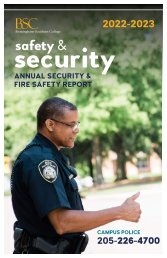
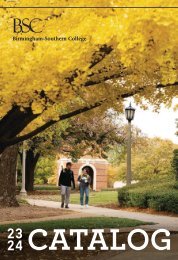
![2023-2024 BSC Catalog Updated_UG ONLY_FINAL[82]](https://img.yumpu.com/68414854/1/178x260/2023-2024-bsc-catalog-updated-ug-only-final82.jpg?quality=85)






